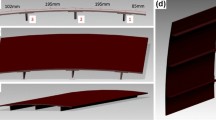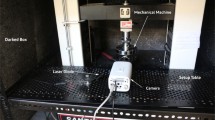Abstract
A non-destructive method for distinguishing intact potato tubers from those already exposed to mechanical damage (pressure and impact stresses) has been evaluated on three potato varieties (Agria, Marfona, and Diamant) using four pairs of ceramic ultrasonic transducers (25, 32.8, 40, and 50-kHz). Attenuation coefficient of the ultrasonic wave was used as the parameter to determine the tuber damage condition. The results obtained from 25-kHz transducers were more accurate than those from other frequencies. Results of the 25-kHz tests showed accuracies of 83%, 94.5%, and 89% in differentiating damaged tubers from intact ones for Agria, Marfona, and Diamant, respectively. In order to determine deformation energy and tangential elastic modulus of potato varieties, triaxial and uniaxial tests were used. Due to the higher average values of tangential elastic modulus in the Agria variety, it was concluded that the potato tubers of this variety are stiffer than those of Marfona and that; therefore, there is a higher ultrasonic attenuation in Agria tubers.
Resumen
Se evaluó un método no destructivo para distinguir los tubérculos de papa intactos de los que ya fueron expuestos a daños mecánicos (presión e impacto) en tres variedades (Agria, Marfona y Diamant), con cuatro pares de transductores ultrasónicos de cerámica (25, 32, 40 y 50 kHz). Se utilizó como parámetro el coeficiente de atenuación de la onda ultrasónica para determinar la condición de daño al tubérculo. Los resultados obtenidos de 25 kHz transductores fueron más precisos que los de otras frecuencias. Los resultados de las pruebas de 25 kHz mostraron una precisión de 83%, 94.5% y 89% en la diferenciación de los tubérculos dañados por los intactos para Agria, Marfona y Diamant, respectivamente. Con el fin de determinar la energía de deformación y módulo de elasticidad tangencial de las variedades de papa, se utilizaron las pruebas triaxial y tangencial. Debido a los valores promedio mas altos de la tangencial de módulo de elasticidad de la variedad Agria, se concluye que los tubérculos de papa de la variedad Agria son más rígidos que los de Marfona, y por tanto, hay una mayor atenuación ultrasónica en tubérculos de Agria.





Similar content being viewed by others
References
Baritelle, A.L., and G.M. Hyde. 2003. Specific gravity and cultivar effects on potato tuber impact sensitivity. Postharvest Biology and Technology 29: 279–286.
Bechar, A., A. Mizrach, P. Barreiro, and S. Landahl. 2005. Determination of mealiness in apples using ultrasonic measurements. Biosystems Engineering 91: 329–334.
Blahovec, J., and J. Zidova. 2004. Potato bruises spot sensitivity dependence on modes of cultivation. Research in Agricultural Engineering 50: 89–95.
Cao, S., Z. Hu, and B. Pang. 2010. Optimization of postharvest ultrasonic treatment of strawberry fruit. Postharvest Biology and Technology 55: 150–153.
Cheeke, J.D.N. 2002. Fundamentals and applications of ultrasonic waves. CRC Press, LLC.
Cheng, Y., and C.G. Haugh. 1994. Detecting hollow heart in potatoes using ultrasound. Transactions of the ASAE 37(1): 217–222.
Dolatowski, Z.J., J. Stadnik, and D. Stasiak. 2007. Applications of ultrasound in food technology. Acta Scientiarum Polorum - Technologia Alimentaria 6: 89–99.
Esehaghbeygi, A., and S. Besharati. 2009. Potato variety and storage for tuber sensitivity in bruising. World Applied Sciences Journal 7(12): 1504–1507.
Flitsanov, U., A. Mizrach, A. Liberzon, A. Akerman, and G. Zauberman. 2000. Measurement of avocado softening at various temperatures using ultrasound. Postharvest Biology and Technology 20: 279–286.
Fluck, R.C., F.S. Wright, and W.E. Splinter. 1968. Compression plunger skinning and friction properties of sweet potato. Transactions of the ASAE 11(167–170): 174.
Ha, K., H. Kanai, N. Chubachi, and K. Kamimura. 1991. A Basic study on nondestructive evaluation of potatoes using ultrasound. Japanese Journal of Applied Physics, Part 1 30: 80–82.
Hentzschel, F., and J.J. Ammann. 2004. High-frequency ultrasonic characterization of kiwifruit through attenuation and sound velocity determination, In Proceedings of 14th Symposium Physics of Chile, Antofagasta, Chile.
Jivanuwong, S. 1998. Nondestructive detection of hollow heart in potatoes using ultrasonics, Ms Thesis, Virginia Polytechnic Institute and State University.
Kim, K.B., S. Lee, M.S. Kim, and B.K. Cho. 2009. Determination of apple firmness by non-destructive ultrasonic measurement. Postharvest Biology and Technology 52: 44–48.
Laerke, P.E., J. Christiansen, and B. Veierskov. 2002. Color of blackspot bruises in potato tubers during growth and storage compared to their discoloration potential. Postharvest Biology and Technology 26: 99–111.
Mathew, R., and G.M. Hyde. 1997. Potato impact damage thresholds. Transactions of the ASAE 40: 705–709.
Mizrach, A. 2000. Determination of avocado and mango fruit properties by ultrasonic technique. Ultrasonics 38: 717–722.
Mizrach, A. 2007. Nondestructive ultrasonic monitoring of tomato quality during shelf-life storage. Postharvest Biology and Technology 46: 271–274.
Mizrach, A. 2008. Ultrasonic technology for quality evaluation of fresh fruit and vegetables in pre- and postharvest processes. Postharvest Biology and Technology 48: 315–330.
Mizrach, A., U. Flitsanov, and Y. Fuchs. 1997. An ultrasonic nondestructive method for measuring maturity of mango fruit. Transactions on the ASAE 40: 1107–1111.
Sadowska, J., J. Fornal, and Z. Kazimiera. 2008. The distribution of mechanical resistance in potato tuber tissues. Postharvest Biology and Technology 48: 70–76.
Stroshine, H., and H. Hammand. 1994. Physical properties of agricultural and food materials. University of Purdue.
Vertregt, N. 1968. Relation between blackspot and composition of the potato tuber. European Potato Journal 11: 34–44.
Zitter, T.A., and R. Loria. 2000. Detection of potato tuber diseases and defects. Cornell University Information, Bulletin 205.
Acknowledgments
The authors would like to thank Amin Mirkalantari, department of electrical engineering for his guides, and providing the laboratory facilities.
Author information
Authors and Affiliations
Corresponding author
Rights and permissions
About this article
Cite this article
Esehaghbeygi, A., Raghami, N. & Kargar, A. Detection of Internal Defects in Potato Based on Ultrasound Attenuation. Am. J. Pot Res 88, 160–166 (2011). https://doi.org/10.1007/s12230-010-9177-9
Published:
Issue Date:
DOI: https://doi.org/10.1007/s12230-010-9177-9




